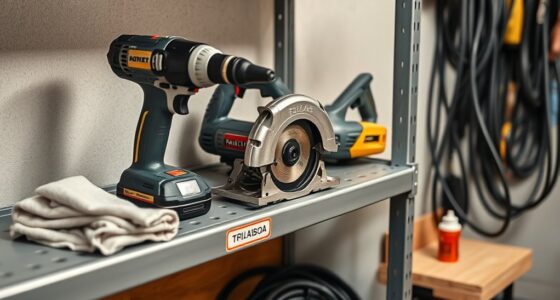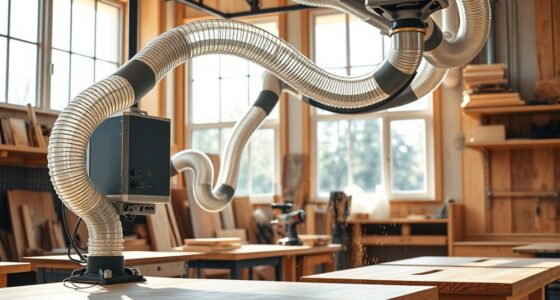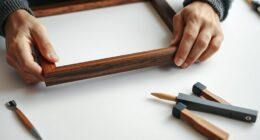Getting started with a Dremel rotary tool involves familiarizing yourself with its functions and safety precautions. Begin by choosing the right attachment for your project and securing it properly. Always wear safety goggles, keep the workspace well-ventilated, and unplug the tool before changing accessories. Practice controlling the tool at a steady pace to ensure safety and precision. If you want to master these steps and learn helpful tips, keep going for detailed guidance.
Key Takeaways
- Read the user manual thoroughly to understand your specific Dremel model and safety guidelines.
- Wear safety goggles and ensure proper ventilation before operating the tool.
- Choose and securely attach the appropriate accessory for your project, following safety procedures.
- Practice controlling the Dremel at low speeds on scrap material to build confidence.
- Regularly inspect and maintain the tool for optimal performance and safety.

A Dremel rotary tool is a versatile device that can handle a wide range of projects, from engraving to sanding. Before diving into your first project, it’s essential to understand safety precautions. Always wear safety goggles to protect your eyes from debris and dust. Keep your workspace well-ventilated, especially when working with materials that produce fumes or fine particles. Avoid loose clothing or jewelry that could get caught in the spinning attachment. Secure your workpiece firmly, and hold the tool steadily to maintain control. Never force the tool; let it do the work at its own pace. If you’re using cutting or grinding attachments, be particularly cautious, as they can generate sparks or heat. Unplug the tool when changing accessories, and never force a bit into the collet—use the appropriate wrench if needed. Familiarize yourself with the user manual, which provides specific safety tips and instructions for your model. Following these safety precautions helps prevent accidents and ensures a more enjoyable experience. Additionally, understanding the effectiveness and safety of different attachments can help you choose the right tools for your projects.
Tool maintenance is equally important for safe operation and peak performance. Regularly inspect your Dremel for signs of wear or damage, such as cracks, worn-out brushes, or loose attachments. Keep the tool clean by removing dust and debris after each use, especially around vents and motor areas. Use a soft brush or compressed air—carefully—avoiding moisture that could damage internal components. Lubricate moving parts as recommended in the manual to ensure smooth operation. When replacing attachments, always disconnect the power first, then carefully remove the old bit and install the new one properly, tightening it securely. Proper maintenance also means storing your Dremel in a dry, safe place, away from dust and moisture. This not only prolongs the life of the tool but also guarantees safety during subsequent uses. If you notice unusual noises, overheating, or decreased performance, consult the manual or contact customer support for troubleshooting tips.
Getting familiar with your Dremel’s features and practicing proper safety precautions and tool maintenance will give you confidence as you start your projects. Take your time to learn how each attachment works and experiment with different materials. Remember, a well-maintained tool combined with safety awareness creates a safer environment and produces better results. By staying attentive to safety and care, you’ll enjoy using your Dremel for years to come, turning your creative ideas into reality with ease and confidence.
Frequently Asked Questions
How Do I Change Dremel Accessories Safely?
When changing Dremel accessories, you should first make certain your tool is unplugged or the battery is removed for safety. Check that the accessory is compatible with your Dremel model to avoid damage. Loosen the collet with the provided wrench, remove the old accessory, and insert the new one securely. Store your accessories properly in designated accessory storage to keep everything organized and easily accessible for your next project.
What Materials Can I Cut With a Dremel?
Did you know that a Dremel can cut through over 20 different materials? You can use it to cut delicate materials like glass or plastic, as well as abrasive materials like metal or ceramic. Its versatility makes it perfect for detailed projects. Just make sure you select the right attachment and safety gear. With proper technique, you’ll easily handle cutting tasks that require precision and care.
How Do I Control the Speed Effectively?
To control the speed effectively, you should adjust the speed control dial on your Dremel. Start at a lower setting for delicate tasks and increase as needed for tougher materials. Make sure to check the accessory adjustment before use to verify it’s secure and properly aligned. Consistently monitor the tool’s performance, and adjust the speed control as you work to maintain precision and avoid damaging your project.
What Safety Gear Should I Use?
Imagine donning a suit of armor before a daring quest. You should always wear protective eyewear to shield your eyes from flying debris and dust mask to prevent inhaling fine particles. These safety gears act like your personal shield, ensuring you stay safe while working on your project. By prioritizing these items, you protect your health and make your creative process safer and more enjoyable.
How Do I Troubleshoot Common Dremel Issues?
When troubleshooting common Dremel issues, start with maintenance tips like cleaning the vents and checking for debris. Make certain your accessories are compatible with your model, as incompatible parts can cause problems. If your tool stalls or runs poorly, try replacing worn-out brushes or inspecting the power cord. Always turn off and unplug the device before maintenance. Regularly maintaining your Dremel keeps it running smoothly and extends its lifespan.
Conclusion
Now that you know the basics, you’re ready to tackle your DIY projects with confidence. Did you know that Dremel tools can handle over 30 different attachments? That versatility means endless possibilities for your creativity. Just remember to start slow, wear safety gear, and practice. With a little patience, you’ll be surprised how quickly your skills improve. Get ready to transform your ideas into reality and enjoy the satisfying results of your newfound craftsmanship.









